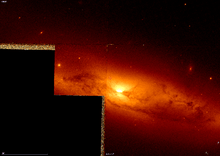NGC 4293
NGC 4293 is a lenticular galaxy in the northern constellation of Coma Berenices. It was discovered by English astronomer William Herschel on March 14, 1784, who described it as "large, extended, resolvable, 6 or 7′ long". This galaxy is positioned to the north-northwest of the star 11 Comae Berenices and is a member of the Virgo Cluster of galaxies.[5] It is assumed to lie at the same distance as the Virgo Cluster itself: around 54 million light years away.[4] The galaxy spans an apparent area of 5.3 × 3.1 arc minutes.[5]
| NGC 4293 | |
|---|---|
 Partial image of NGC 4293 taken by the Hubble Space Telescope | |
| Observation data (J2000 epoch) | |
| Constellation | Coma Berenices |
| Right ascension | 12h 21m 12.891s[1] |
| Declination | +18° 22′ 56.64″[1] |
| Redshift | 0.002977[2] |
| Helio radial velocity | 893[3] |
| Distance | 54 Mly (16.5 Mpc)[4] |
| Group or cluster | Virgo Cluster |
| Apparent magnitude (V) | 10.4[5] |
| Characteristics | |
| Type | (R)SB(s)0/a[6] |
| Apparent size (V) | 5.293′ × 1.800′[1] |
| Other designations | |
| 2MASX J12211289+1822566, IRAS 12186+1839, LEDA 39907, UGC 7405, UZC J122112.6+182256, Z 99-23, VCC 460.[7] | |
The morphological classification of NGC 4293 is (R)SB(s)0/a, with the SB0/a indicating this has just distinguishable tightly wound spiral arms with a bar structure at the nucleus. An '(s)' notation means that this galaxy does not have a ring-like structure around the nucleus.[6][8] Star formation within NGC 4293 is only taking place within a confined region at the center of the galaxy.[9] The outer stellar disk of the galaxy appears disturbed, suggesting some form of gravitational interaction.[10]
This is a common type of active galaxy known as a LINER, which means that the optical spectrum is dominated by emission lines from gases in low energy ionization states. The activity may be the result of a supermassive black hole (SMBH) in the nucleus that is undergoing a low rate of matter accretion. The estimated mass of such an SMBH is 5.9×107 M⊙.[11] Radio emission from thermal activity has been detected from the proximity of this object.[12]
References
- Skrutskie, M. F.; et al. (February 2006), "The Two Micron All Sky Survey (2MASS)", Astrophysical Journal, 131 (2): 1163–1183, Bibcode:2006AJ....131.1163S, doi:10.1086/498708.
- Kochanek, C. S.; et al. (October 2001), "The K-Band Galaxy Luminosity Function", The Astrophysical Journal, 560 (2): 566–579, arXiv:astro-ph/0011456, Bibcode:2001ApJ...560..566K, doi:10.1086/322488.
- Crook, Aidan C.; et al. (February 2007), "Groups of Galaxies in the Two Micron All Sky Redshift Survey", The Astrophysical Journal, 655 (2): 790–813, arXiv:astro-ph/0610732, Bibcode:2007ApJ...655..790C, doi:10.1086/510201.
- Cappellari, Michele; et al. (May 2011), "The ATLAS3D project - I. A volume-limited sample of 260 nearby early-type galaxies: science goals and selection criteria", Monthly Notices of the Royal Astronomical Society, 413 (2): 813–836, arXiv:1012.1551, Bibcode:2011MNRAS.413..813C, doi:10.1111/j.1365-2966.2010.18174.x.
- O'Meara, Stephen James (2011), Deep-Sky Companions: The Secret Deep, 4, Cambridge University Press, pp. 230–231, ISBN 978-1139500074.
- de Vaucouleurs, G.; et al. (1991), "Third reference catalogue of bright galaxies, version 9", The Astronomical Journal, 108: 2128, Bibcode:1994AJ....108.2128C, doi:10.1086/117225, retrieved 2015-11-25.
- "NGC 4293". SIMBAD. Centre de données astronomiques de Strasbourg. Retrieved 2015-11-16.
- Keel, William C. (January 2015), Galaxy Classification, University of Alabama, retrieved 2015-11-25.
- Falcón-Barroso, J.; et al. (December 2009), "Galaxy Evolution: Emerging Insights and Future Challenges ASP Conference Series", in Jogee, S.; Marinova, I.; Hao, L.; et al. (eds.), Galactic Bulges: the SAURON Perspective, 419, Society of the Pacific, 2009, p. 131, Bibcode:2009ASPC..419..131F.
- Cortés, J. R.; et al. (June 2006), "XI IAU Regional Latin American Meeting of Astronomy", in Infante, L.; Rubio, M. (eds.), Stellar and Ionized Gas Kinematics of Peculiar Virgo Cluster Galaxies, 26, Revista Mexicana de Astronomía y Astrofísica, p. 189, arXiv:astro-ph/0602627, Bibcode:2006RMxAC..26Q.189C.
- Chiaberge, Marco; et al. (June 2005), "The Hubble Space Telescope View of LINER Nuclei: Evidence for a Dual Population?", The Astrophysical Journal, 625 (2): 716–726, arXiv:astro-ph/0501461, Bibcode:2005ApJ...625..716C, doi:10.1086/429612.
- Filho, M. E.; Barthel, P. D.; Ho, L. C. (May 2006), "A radio census of nuclear activity in nearby galaxies", Astronomy and Astrophysics, 451 (1): 71–83, arXiv:astro-ph/0601080, Bibcode:2006A&A...451...71F, doi:10.1051/0004-6361:20054510.